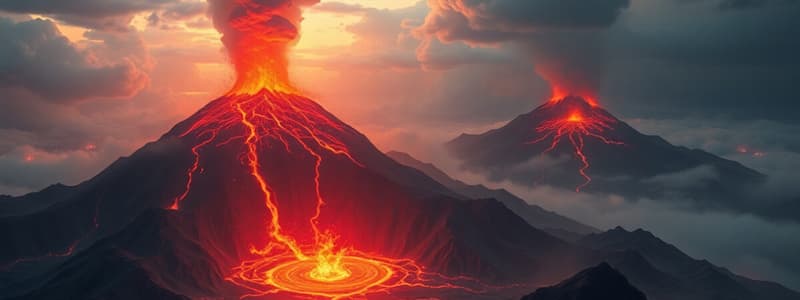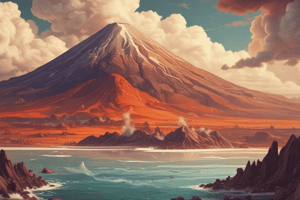Podcast
Questions and Answers
Faults are common at ______ boundaries.
Faults are common at ______ boundaries.
transform
Mountain ranges like the Himalayas are formed at ______ boundaries.
Mountain ranges like the Himalayas are formed at ______ boundaries.
convergent
Heat from the Earth's core causes ______ currents in the mantle.
Heat from the Earth's core causes ______ currents in the mantle.
convection
Identical fossils of the Mesosaurus suggest that continents were once ______.
Identical fossils of the Mesosaurus suggest that continents were once ______.
Earthquakes and volcanoes are concentrated along tectonic plate ______.
Earthquakes and volcanoes are concentrated along tectonic plate ______.
Active volcanoes are primarily found at tectonic plate ______.
Active volcanoes are primarily found at tectonic plate ______.
The location directly above where an earthquake originates is called the ______.
The location directly above where an earthquake originates is called the ______.
Major mountain ranges like the Himalayas are formed at ______ boundaries.
Major mountain ranges like the Himalayas are formed at ______ boundaries.
At divergent boundaries, two tectonic plates move ______ from each other.
At divergent boundaries, two tectonic plates move ______ from each other.
The process where one tectonic plate sinks beneath another is called ______.
The process where one tectonic plate sinks beneath another is called ______.
Sea-floor spreading occurs at ______ boundaries.
Sea-floor spreading occurs at ______ boundaries.
Transform boundaries can cause ______ as two plates slide past each other.
Transform boundaries can cause ______ as two plates slide past each other.
Faulting occurs when stress builds up along a ______.
Faulting occurs when stress builds up along a ______.
Flashcards are hidden until you start studying
Study Notes
Active Geological Features
- Active Volcanoes: Primarily located at convergent and divergent tectonic plate boundaries; the Pacific Ring of Fire hosts the majority of these volcanoes.
- Earthquake Epicenters: Occur at tectonic plate interactions along fault lines; epicenters are directly above the earthquake's origin and are typically found near plate boundaries.
- Mountain Belts: Formed at convergent boundaries through the collision and crumpling of tectonic plates; notable examples are the Himalayas and Andes.
Plate Boundary Types
- Divergent Boundaries: Plates move apart, allowing magma to rise and create new crust (e.g., Mid-Atlantic Ridge).
- Convergent Boundaries: Plates collide, often leading to subduction; this results in volcanic activity and mountain formation (e.g., the Andes and Himalayas).
- Transform Boundaries: Plates slide past each other horizontally, causing stress that can result in earthquakes; a well-known example is the San Andreas Fault.
Geological Processes
- Subduction: Occurs at convergent boundaries with one plate sinking beneath another, leading to volcanic activity and trench formation.
- Sea-Floor Spreading: Takes place at divergent boundaries, where magma creates new oceanic crust at mid-ocean ridges.
- Faulting: Can happen along transform boundaries when accumulated stress leads to rocks breaking and slipping, resulting in earthquakes.
- Mountain Formation: Large mountain ranges develop at convergent boundaries through the collision of plates, with both rising and folding.
Causes of Plate Movement
- Mantle Convection: Heat from Earth's core generates convection currents in the mantle, driving plate movements.
- Ridge Push: Elevation of newly formed lithosphere at mid-ocean ridges causes gravitational sliding of plates away from ridges.
- Slab Pull: Pulling effect of denser, cold plate segments at subduction zones advances plate motion downward into the mantle.
Evidence for Plate Tectonics
- Fossil Distribution: Shared fossils of species like Mesosaurus found on distant continents suggest their prior connection.
- Fit of the Continents: Continental coastlines, especially Africa and South America, align like a jigsaw puzzle, indicating a historical supercontinent.
- Paleomagnetism: Changes in Earth's magnetic field recorded in rocks show shifts of magnetic poles over time, supporting sea-floor spreading.
- Concentration of Seismic Activity: Earthquakes and volcanoes cluster along tectonic boundaries, especially the Ring of Fire, illustrating active plate tectonics.
Studying That Suits You
Use AI to generate personalized quizzes and flashcards to suit your learning preferences.




